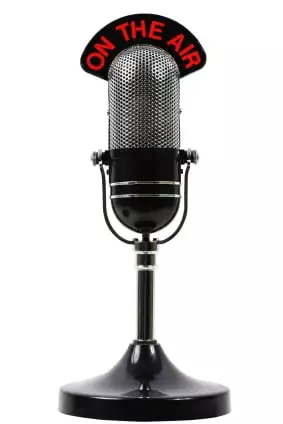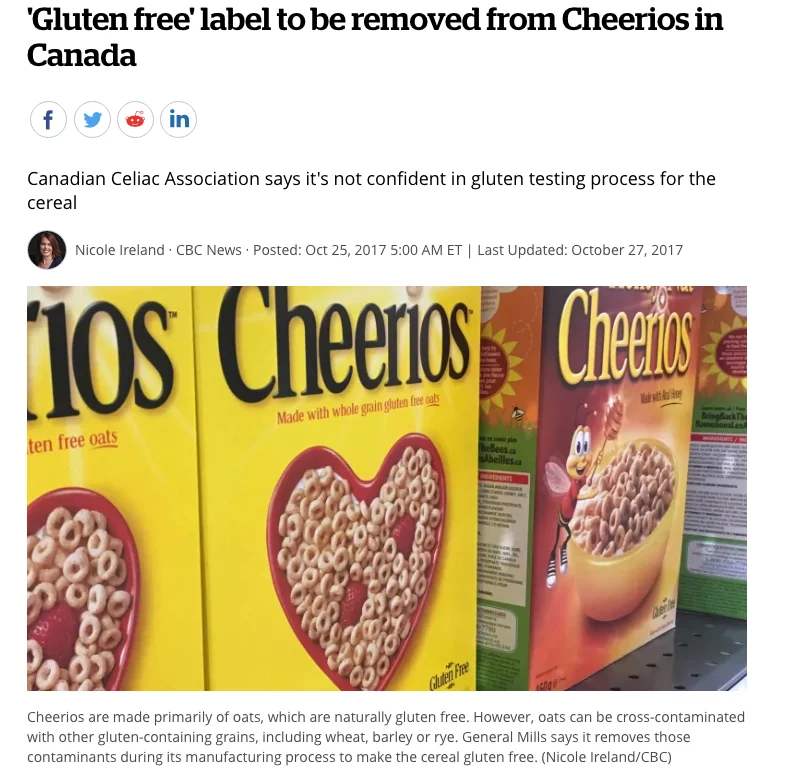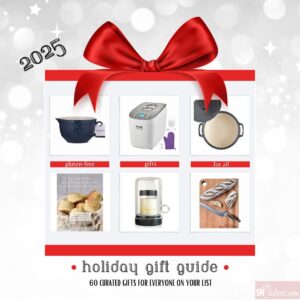Is There Gluten In Cheerios?!
 You may have heard about the infamous General Mills Cheerios recall of some lots of Yellow Box and Honey Nut Cheerios labeled as GLUTEN FREE due to gluten contamination, after reports of consumer illness. Here’s the scoop:
You may have heard about the infamous General Mills Cheerios recall of some lots of Yellow Box and Honey Nut Cheerios labeled as GLUTEN FREE due to gluten contamination, after reports of consumer illness. Here’s the scoop:
Gluten in Cheerios 2015
General Mills® announced in 2015 that certain varieties of Cheerios would be made using oats that would be mechanically separated to reduce the amount of gluten-containing grains contaminating the batch (rather than using oats grown, harvested and packaged using the “purity protocol“).*
They claimed that each batch would be tested in-house, but the method they used for testing combined multiple boxes which were then ground and the “lot mean” was tested, rather than testing individual boxes for hot spots of contamination.
A Change.org petition was started by some passionate gluten-free bloggers who were afraid for the health of those in the gluten free community who were trusting in the safety of these General Mills products. The flawed testing protocols and the fact that “pure” gluten-free oats were not being used caused great concern to many who had taken the time to look deeper into how General Mills was producing this product.
There were soon reports of consumer illness, with the FDA testing samples and finding higher than allowed levels of gluten in some. A sample testing at 43ppm was from one of the recalled lots. (If you have been made sick by Cheerios or any other product, please contact the FDA MEDWATCH Adverse Event Reporting System (800) 332-1088 (choose option #4 to speak to a representative) or online.)
Then in October, 2015 General Mills disclosed that its Lodi, California plant had failed to test any of the lots of “gluten free” Cheerios for a period of 13 days. During this period, the oats had also been transported in containers which had been used for wheat, so the oats were further contaminated — a situation General Mills was unaware of until customer complaints lodged with the Gluten Free Watchdog and later with the FDA brought it to their attention, necessitating a recall of 1.8 million boxes produced during that 13 day period.
Gluten in Cheerios 2016
The Canadian Celiac Associate (CCA) reacted to the news that General Mills was introducing “gluten free” Cheerios to Canada, but being made with mechanically or optically sorted oats, not with purity protocol oats. Here is an excerpt from their position statement recommending that celiacs NOT eat these Cheerios or any other products made with sorted oats:
We know the following:
- Oats are an extremely high risk grain and even “gluten-free oats” are at high risk for gluten contamination.
- It is very difficult to remove gluten-containing grains from oats using optical and mechanical technology alone because barley and wheat are similar in size, shape and color as oats. Broken kernels present in the grain also add to the sorting challenge.
- General Mills is using a cleaning system that they developed based on mechanical sorting to remove barley and wheat from regular commercial oats.
- Gluten contamination in oats is not distributed evenly through a batch; therefore, “hot spots” of high contamination can occur.
Based on the information provided to date, our scientific advisors are not convinced that the testing procedures described by General Mills are sufficient to detect these contamination “hot spots” in the oats and oat flour or in the boxes of cereal that may contain those contaminated oats. As a result, some boxes of cereal in the market may be safe for people with celiac disease while others contain significant gluten contamination that has not been detected using current testing protocols.
The CCA is receptive to evaluating any additional information that General Mills is willing to disclose. Until then, the CCA stands by its advice that people with celiac disease or gluten sensitivity should not consume Cheerios products in spite of the gluten-free claim.
Gluten in Cheerios 2017
Reports of illness from Cheerios continued to stream in to the FDA. Buzzfeed filed a Freedom of Information Request and reported on the claims which were still being made by celiacs and others who say they’ve been sickened by Cheerios. Jocelyn Silvester, a physician at Boston Children’s Hospital, says that her team recommends patients with celiac disease avoid products made with mechanically-optically separated oats, noting that it remains unclear whether any given product is safe and there is no reliable tool to find out for sure.
The Canadian Celiac Association then released this news: “The Canadian Food Inspection Agency (CFIA) has made an announcement that the words “gluten-free” will be removed from all Cheerios package sold in Canada by January 1, 2018.” However, General Mills has said it will not remove any boxes currently labeled gluten-free; it will not label Cheerios as gluten-free with replenishment of stock.
Melissa Secord, Executive Director of the Canadian Celiac Association elaborated, “Based on the advice of the members of our Professional Advisory Board, the experts of the Gluten-Free Certification Program, and other professionals working in the field, we believe that there is not adequate evidence to support the claim. When added to many reports from consumers with celiac disease reacting to eating the cereal, we believe this is the safe recommendation for Canadians.”

Gluten in Cheerios 2021:
General Mills is still using mean test results from a composite sample made up of sub samples taken from 12 to 18 boxes of cereal to determine if a “lot” — a 24 hour production cycle — is gluten-free. Using this testing method, if high results are found, General Mills has no idea which box is to blame and “hot spots” are not accounted for.
For more information on why gluten-free experts are not satisfied with General Mills’ current testing protocols for Cheerios boxes labeled “gluten free,” go to The Gluten Free Watchdog.
 To learn more about “mechanically separated” versus “purity protocol” oats, listen to this “You Had Me At Eat” free podcast.
To learn more about “mechanically separated” versus “purity protocol” oats, listen to this “You Had Me At Eat” free podcast.
For a CERTIFIED GLUTEN-FREE Os cereal option, try Three Wishes Cereal instead!

























Trust but verify! Said Ronald Reagan.
Watch out – these Cheerios sting!
it taste so so good, of course it has gluten in it!
How many people can I hoodwink with my wand and aggressive marketing campaign… Big companies never lie to consumers!